Related Research Articles
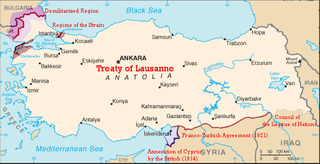
The Treaty of Lausanne is a peace treaty negotiated during the Lausanne Conference of 1922–23 and signed in the Palais de Rumine in Lausanne, Switzerland, on 24 July 1923. The treaty officially resolved the conflict that had initially arisen between the Ottoman Empire and the Allied French Republic, British Empire, Kingdom of Italy, Empire of Japan, Kingdom of Greece, Kingdom of Serbia, and the Kingdom of Romania since the outset of World War I. The original text of the treaty is in English and French. It emerged as a second attempt at peace after the failed and unratified Treaty of Sèvres, which had sought to partition Ottoman territories. The earlier treaty, signed in 1920, was later rejected by the Turkish National Movement which actively opposed its terms. As a result of the Greco-Turkish War, İzmir was reclaimed, and the Armistice of Mudanya was signed in October 1922. This armistice provided for the exchange of Greek-Turkish populations and allowed unrestricted civilian, non-military passage through the Turkish Straits.
In the Ottoman Empire, a millet was an independent court of law pertaining to "personal law" under which a confessional community was allowed to rule itself under its own laws.
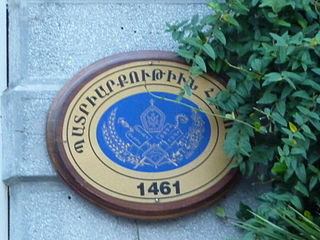
The Armenian Patriarchate of Constantinople is an autonomous see of the Armenian Apostolic Church. The seat of the Armenian Patriarchate of Constantinople is the Surp Asdvadzadzin Patriarchal Church in the Kumkapı neighborhood of Istanbul.
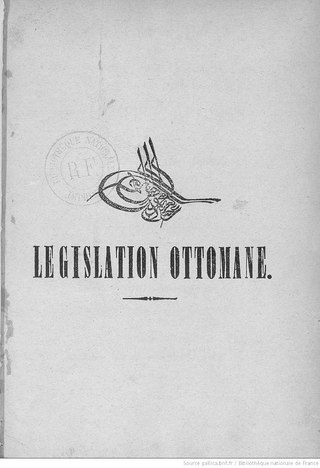
The Imperial Reform Edict was a February 18, 1856 edict of the Ottoman government and part of the Tanzimat reforms. The decree from Ottoman Sultan Abdulmejid I promised equality in education, government appointments, and administration of justice to all regardless of creed. The decree is often seen as a result of the influence of France and Britain, which assisted the Ottoman Empire against the Russians during the Crimean War (1853–1856) and the Treaty of Paris (1856) which ended the war.

The Young Turk Revolution was a constitutionalist revolution in the Ottoman Empire. Revolutionaries belonging to the Internal Committee of Union and Progress, an organization of the Young Turks movement, forced Sultan Abdul Hamid II to restore the Constitution, recall the parliament, and schedule an election. Thus began the Second Constitutional Era.

The Urfa resistance was an effort by some Ottoman Armenians in Urfa to defend themselves against the Armenian genocide launched by the Ottoman Empire. The resistance was quelled following German intervention.
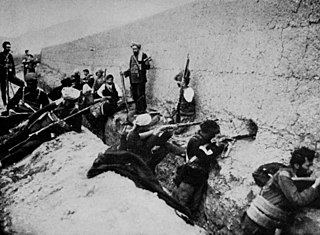
Armenian resistance included military, political, and humanitarian efforts to counter Ottoman forces and mitigate the Armenian genocide during the first World War. Early in World War I, the Ottoman Empire commenced efforts to eradicate Armenian culture and eliminate Armenian life, through acts of killing and death marches into uninhabitable deserts and mountain regions. The result was the homogenisation of the Ottoman Empire and elimination of 90% of the Armenian Ottoman population.
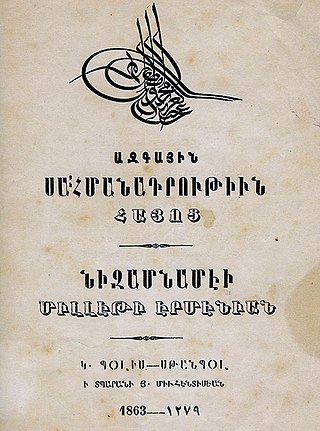
The Armenian National Constitution or Regulation of the Armenian Nation was a constitution in the Ottoman Empire for members of the Gregorian Armenian Millet. Promulgated in 1863, it defined the powers of the Armenian Patriarch, a newly formed Armenian National Assembly, and lay members. This code is still active among Armenian Church in diaspora. The Ottoman Turkish version was published in the Düstur. Other constitutions were promulgated for the Catholic Armenian and the Protestant Armenian millets.
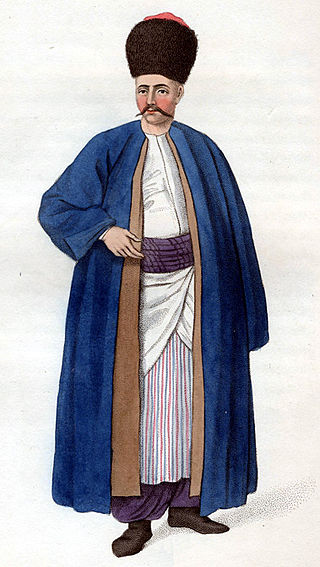
Armenians were a significant minority in the Ottoman Empire. They belonged to either the Armenian Apostolic Church, the Armenian Catholic Church, or the Armenian Protestant Church, each church serving as the basis of a millet. They played a crucial role in Ottoman industry and commerce, and Armenian communities existed in almost every major city of the empire. The majority of the Armenian population made up a reaya, or peasant, class, in Eastern Anatolia. The Tanzimat reforms in the nineteenth century sought to manifest the doctrine of equality before the law. Despite their importance, Armenians were persecuted by the Ottoman authorities, especially from the latter half of the 19th century, culminating in the Armenian Genocide.
Armenian National Assembly was the governing body of the Armenian millet in the Ottoman Empire, established by the Armenian National Constitution of 1863.

Ottoman Greeks were ethnic Greeks who lived in the Ottoman Empire (1299–1922), much of which is in modern Turkey. Ottoman Greeks were Greek Orthodox Christians who belonged to the Rum Millet. They were concentrated in eastern Thrace, and western, central, and northeastern Anatolia. There were also sizeable Greek communities elsewhere in the Ottoman Balkans, Ottoman Armenia, Ottoman Syria and the Ottoman Caucasus, including in what, between 1878 and 1917, made up the Russian Caucasus province of Kars Oblast, in which Pontic Greeks, northeastern Anatolian Greeks, and Caucasus Greeks who had collaborated with the Russian Imperial Army in the Russo-Turkish War of 1828–1829 were settled in over 70 villages, as part of official Russian policy to re-populate with Orthodox Christians an area that was traditionally made up of Ottoman Muslims and Armenians.

In AD 1453, the city of Constantinople, the capital and last stronghold of the Byzantine Empire, fell to the Ottoman Empire. By this time Egypt had been under Muslim control for some eight centuries. Jerusalem had been conquered by the Rashidun Caliphate Muslims in 638, won back by Rome in 1099 under the First Crusade and then reconquered by Saladin's forces during the siege of Jerusalem in 1187. Later in the seventh Crusade, it was briefly taken back by the Catholics once again. It was conquered by the Ottomans in 1517. Orthodoxy, however, was very strong in Russia which had recently acquired an autocephalous status; and thus Moscow called itself the Third Rome, as the cultural heir of Constantinople. Under Ottoman rule, the Greek Orthodox Church acquired power as an autonomous millet. The ecumenical patriarch was the religious and administrative ruler of the entire "Greek Orthodox nation", which encompassed all the Eastern Orthodox subjects of the Empire.

Rūm millet was the name of the Eastern Orthodox Christian community in the Ottoman Empire. Despite being subordinated within the Ottoman political system, the community maintained a certain internal autonomy.

Sürgün or verb form sürmek was a practice within the Ottoman Empire that entailed the movement of a large group of people from one region to another, often a form of forced migration imposed by state policy or international authority. The practice was also a form of banishment or exile often applied to the elites of Ottoman society, the Pashas. It was most famously used as a method to forcefully displace the native ethnic Armenians by the Young Turk government in 1915, in order to deal with a perceived threat from Armenian partisan groups receiving military support from the Ottoman hostile Russian Empire. These events are listed as one of the methods used to complete the Armenian Genocide.

"They Can Live in the Desert but Nowhere Else": A History of the Armenian Genocide is a book by Ronald Grigor Suny about the Armenian genocide, published by Princeton University Press in 2015. The book was praised as an accessible work that provides the academic consensus on why and how the Armenian genocide occurred.

Pro Armenia (1900–1914) was a French-language fortnightly that took pro-Armenian positions. The goal of the journal was to raise awareness in Europe about the plight of Armenians in the Ottoman Empire. It was founded at the initiative of Christapor Mikaelian, a co-founder of the Armenian Revolutionary Federation, enlisting the help of a number of prominent Dreyfusard and leftist intellectuals. Pierre Quillard was its editor-in-chief and Jean Longuet was its secretary. The members of its editorial committee were Georges Clemenceau, Anatole France, Jean Jaurès, Francis de Pressensé, and Edmond de Roberty. It temporarily ceased publication after the 1908 Ottoman constitutional revolution. It was published again in 1912 and 1913 under the title Pour les Peuples d’Orient. In 1914, the last year that the journal was published, it resumed its original name.

On 24 May 1915, on the initiative of Russia, the Triple Entente—Russia, France, and the United Kingdom—issued a declaration condemning the ongoing Armenian genocide carried out in the Ottoman Empire and threatening to hold the perpetrators accountable. This was the first use of the phrase "crimes against humanity" in international diplomacy, which later became a category of international criminal law after World War II.

Differing views of what caused the Armenian genocide include explanations focusing on nationalism, religion, and wartime radicalization and continue to be debated among scholars. In the twenty-first century, focus has shifted to multicausal explanations. Most historians agree that the genocide was not premeditated before World War I, but the role of contingency, ideology, and long-term structural factors in causing the genocide continues to be discussed.

In 1915, a genocide was committed in Diyarbekir vilayet, claiming the lives of most Armenians, Syriac Christians, Greek Orthodox, and Greek Catholics living there. The genocide was ordered by governor Mehmed Reshid, partly with the backing of the CUP Central Committee.

The Republic of Western Armenia, also known as the State of Armenia, is a government in exile claiming sovereignty over parts of the Armenian highlands including sections of Western Armenia as well as Nagorno–Karabakh, and Nakhichevan. Also, the self-declared country says it has its own presidency, government, parliament, constitution, national anthem and coat of arms.
References
- ↑ Suny, Ronald Grigor (2015). "They Can Live in the Desert but Nowhere Else": A History of the Armenian Genocide. Princeton University Press. p. 48. ISBN 978-1-4008-6558-1.
- ↑ Suny, Ronald Grigor (2015). "They can live in the desert but nowhere else" : a history of the Armenian genocide. Princeton. p. 48. ISBN 978-1-4008-6558-1. OCLC 903685759.
{{cite book}}: CS1 maint: location missing publisher (link) - 1 2 Sharkey, Heather J. (2017). A history of Muslims, Christians, and Jews in the Middle East. Cambridge, United Kingdom. p. 85. ISBN 978-0-521-76937-2. OCLC 995805601.
{{cite book}}: CS1 maint: location missing publisher (link) - ↑ ed., Greene, Molly. (2013). Minorities in the Ottoman Empire. Markus Wiener Publishers. p. 47. ISBN 978-1-55876-228-2. OCLC 1154080153.
{{cite book}}:|last=has generic name (help)CS1 maint: multiple names: authors list (link) - ↑ Davison 1963, p. 123-124.
- ↑ Davison 1963, p. 124.
- 1 2 Davison 1963, p. 125.